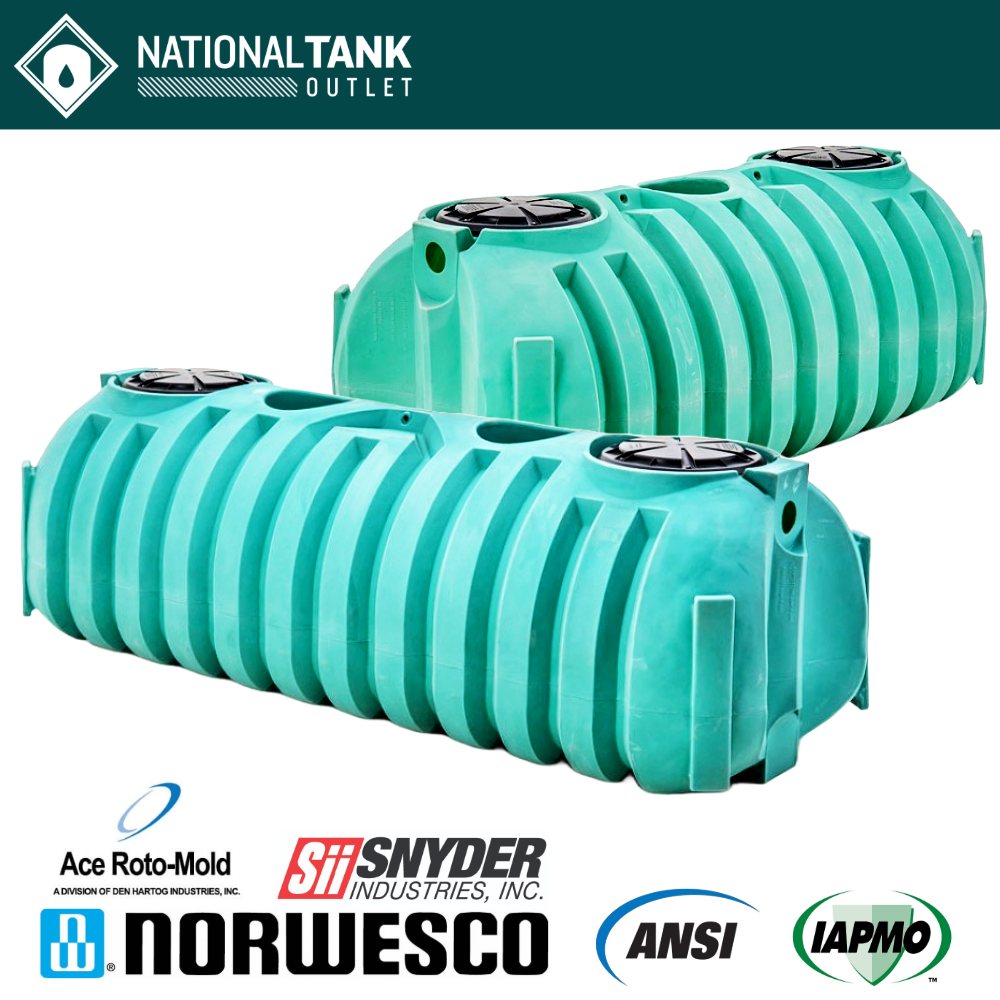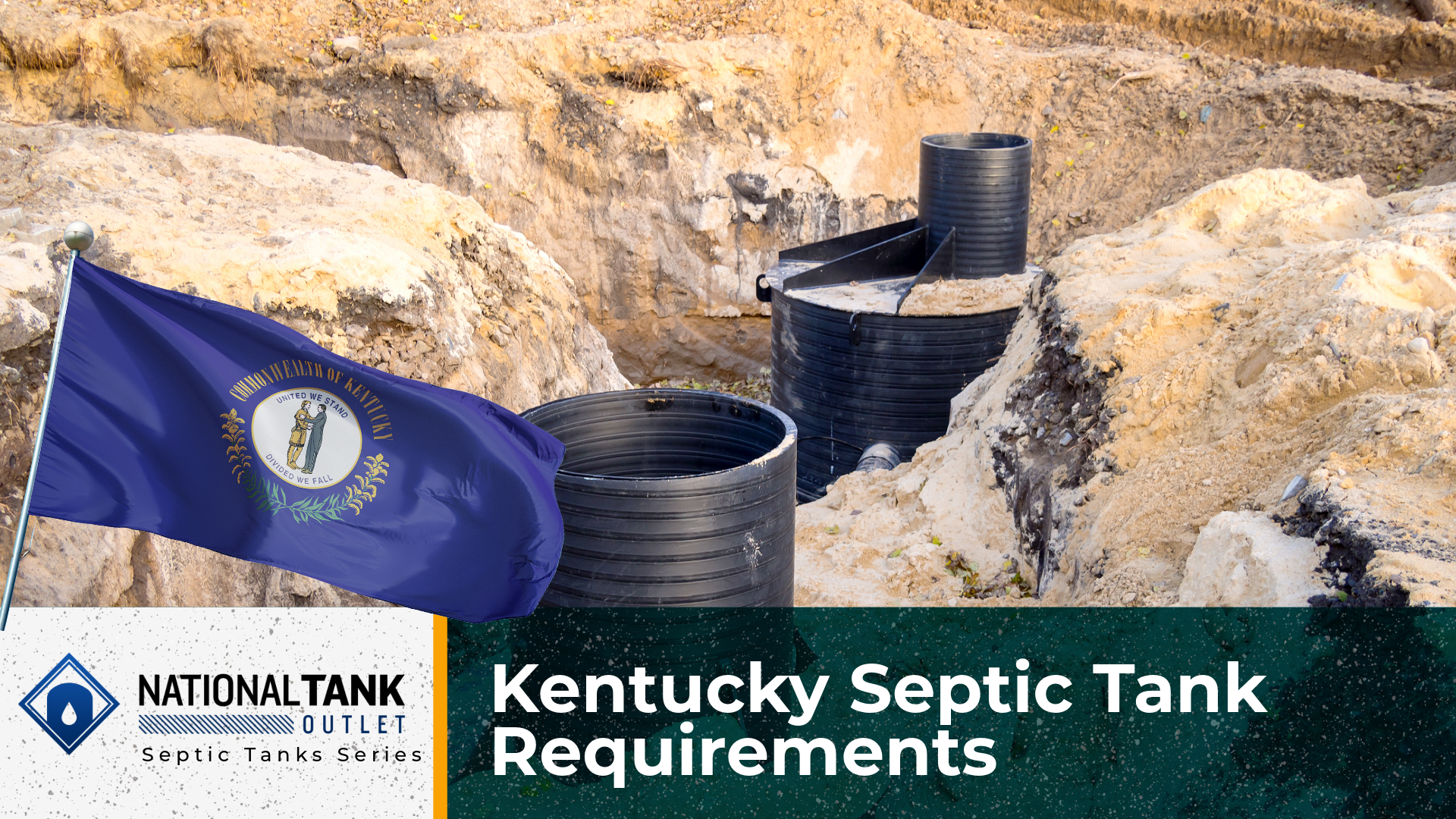
With approximately 60 to 70% of Kentucky residents relying on septic tank systems, understanding the legal codes and installation process becomes vital to public health and the environment. This comprehensive guide covers everything from the state’s regulatory oversight to specific standards for materials, sizes, and components, and answers many of the questions of homeowners and professionals navigating Kentucky septic tank requirements when looking to install a new system in the Bluegrass State.
Whether you’re questioning if a DIY installation is possible or seeking detailed steps for compliance, this article provides the necessary insights. We will outline legal codes governing septic tanks, offer resources on where to find detailed information and break down the step-by-step process to ensure a safe and compliant installation.
Kentucky State Septic Tank Regulations

In Kentucky, state septic tank regulations are overseen by the Department of Public Health (DPH) and the Environmental Management Branch (EMB) in its On-Site Sewage Disposal Systems Program. The Kentucky Department of Public Health is a division of the Kentucky Cabinet for Health and Family Services (CHFS). The KY DPH has been given the legal authority and jurisdiction over septic tank systems by the Kentucky Revised Statutes (KRS) and the state legislature. Septic tank system rules and standards from the DPH Environmental Branch are recorded in Kentucky Administrative Regulations Title 902 Chapter 010 Sanitation in Regulation 081 and Regulation 085.
Regulatory enforcement, permit approvals, and system inspections are passed down from the state Department of Public Health to the local health departments of independent counties or district health departments that oversee a collection of counties. Kentucky has up to fourteen health districts tasked with providing services to the counties within their jurisdiction. See the following for a KY DPH provided list of district and local health departments in Kentucky.

Kentucky State Requirements on Septic Tanks
Kentucky state legal code has set the following minimum standards and requirements that septic tanks must meet to be approved for installation. The information is for septic tanks that will be used in conventional, gravity fed systems given this type is the most used.
- Tank Material: Septic tanks must be manufactured from durable, long lasting, and corrosion resistant materials, this includes cast in place concrete, prefabricated concrete, molded polyethylene, and fiberglass.
- Watertight: Septic tanks and all components such as pipes and gaskets must be engineered and manufactured from materials known to be watertight.
- Size and Capacity: Minimum septic tank sizes for residential properties start at 1000 gallons and increase with increasing number of bedrooms. When a garbage disposal will be used, minimum septic tank sizes start at 1250 gallons. These capacities are based on an estimated 110 gallons per day for a single family residence. (More on this below.)
- Manholes: Septic tanks must have at least two manholes that are no smaller than 10 inches in diameter and no larger than 24 inches in diameter. Manhole risers of at least 18 inches in diameter must be included to bring septic tank access to surface grade and must include tamper proof lids.
- Compartments: Either single compartment or two compartment septic tanks are acceptable as long as the tank meets the requirement for at least two manholes. It is acceptable to use two septic tanks connected in series.
- Components: A permanent effluent filter must be installed either inside or after a septic tank and must be accessible from the surface. Inlet and outlet baffles, sanitary tees, or other baffle devices are required and must be made from resistant material such as plastic or fiberglass and must be properly installed to maintain a secure, leakproof seal.
- Setback Distances: Septic tanks and the accompanying lateral field must be strategically positioned to be no closer than a set distance from structures and features on and around the property. The minimum setback distances depend on feature type. (More on this below.)
- Inspections and Permits: Septic tank installation and alteration are strictly prohibited without completing the required site evaluations, project approval, and permit from a local health department.
- Municipal or Public Sewer: Septic tank systems are often only permitted if not within a reasonable distance from an operating municipal or public sewer system to which the property could be connected.
The above standards and requirements can be found in KAR Title 902 Chapter 10. Local health departments may have additional rules for the region due to environmental concerns or other conditions. Always consult your local health department to determine any changes or specific requirements when installing a septic tank system, and always verify a septic tank intended for purchase will be approved and suitable for the property.
Kentucky Septic Tank Definitions
Kentucky state code and informational manuals refer to the complete system that receives sewage from a property for its breakdown treatment and drainfield disposal as an On-Site Sewage Disposal System. Additional terms for this include on-site sewage system, on-site system, and simply a septic tank system.
Common Kentucky septic system types include a conventional on-site system with a distribution box and lateral field, a modified conventional system, an alternative system such as an aerobic treatment unit or mound system, and a holding tank setup for scenarios when an on-site system will promptly be installed after or where a public sewer connection will become available in the short future.
Can I Install My Own Septic Tank in Kentucky

In the state of Kentucky, homeowners are not typically allowed or are discouraged from installing their own septic tanks. This is due to the intricacies of complying with state regulations, the detailed process, and the work intensive construction activities. However, with this said, the Kentucky Cabinet for Health and Family Services states: “A homeowner who wishes to install his or her own system must obtain a homeowner’s permit through the local health department.” Also, Kentucky state regulation in Regulation 110 regarding permits says a homeowner may be permitted to install a septic tank given they follow the correct steps, can complete the work in compliance with regulations, and if all work is performed by the homeowner.
This statement would seem to indicate a homeowner could in fact install their own system if they proceed with the necessary steps and have the necessary knowledge to obtain a homeowner’s permit. Given that area-specific jurisdiction regarding septic tanks is handled by county or district health departments, the decision for whether DIY septic tank installation is allowed or prohibited may be handled by the local health department. Some jurisdictions, such as the Kentucky River District, require a septic system to be installed by a certified installer, which is someone who has completed the necessary examination.
If you are interested in installing your own septic tank system DIY in the state of Kentucky, first contact your county or regional health department to find out if it’s permitted and if so, what their specific steps are for you to follow.
In general, the installation, repair, or alteration of a septic tank system is recommended to be carried out by a certified Kentucky onsite septic installer. This recommendation ensures the system will be installed properly and according to state standards and site specific conditions in order to protect public health and the environment.
How to Install a Septic Tank in Kentucky
Installing a septic tank in Kentucky is a step-by-step procedure that must be followed accurately and completed in order. The exact steps may vary by location and by local health department rules. In general, Kentucky septic tank installation will involve:
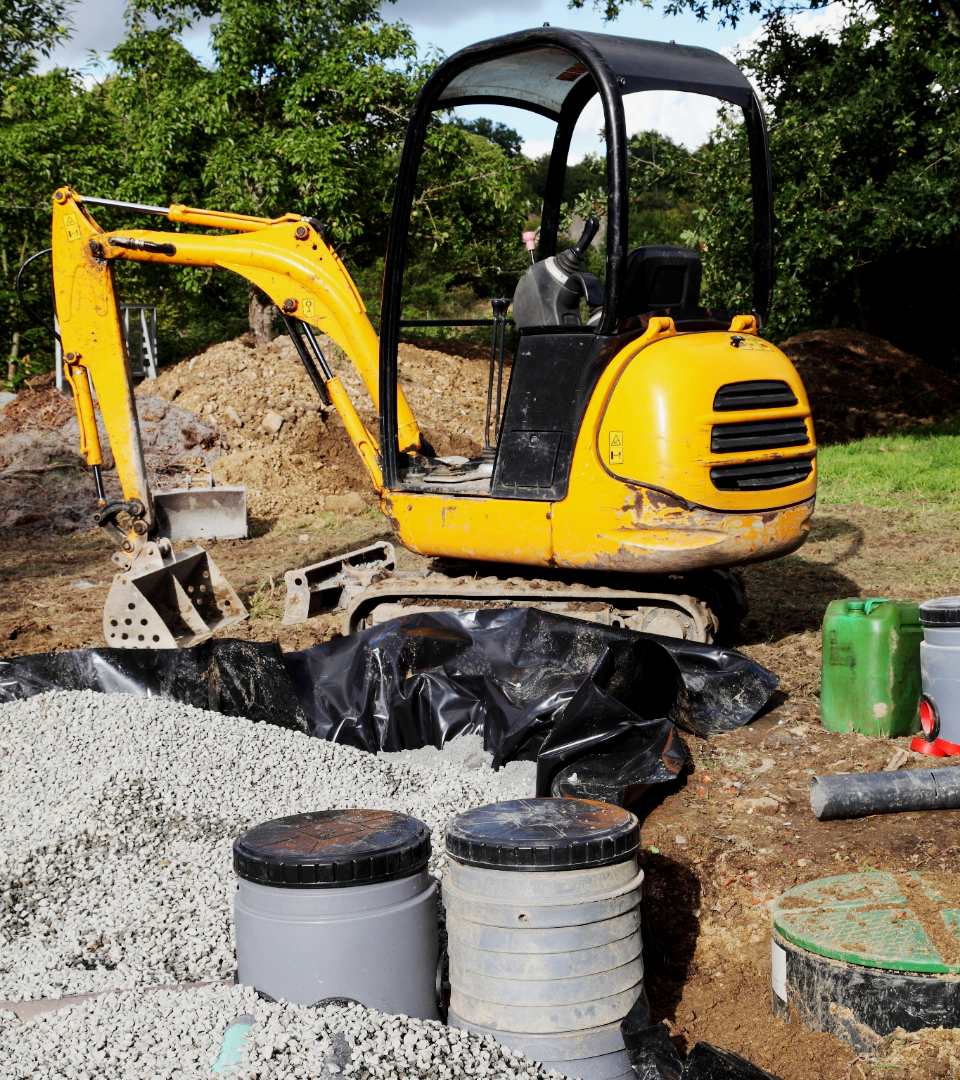
- Point of Contact: Find the right department within your local health department and establish a point of contact for questions and forms for a site evaluation.
- Site Evaluation: File the form to request a site evaluation, if available, to have the property assessed to determine the ideal placement for the septic system, recommended system type, and/or system size.
- System Plan: Prepare a proposed plan for the on-site sewage system, ensuring the plan meets Kentucky regulations for minimum setback distances and follows the recommendations and results from the site evaluation.
- Installation Permit: Acquire and complete the permit application form, providing all required information, for review by the local health department.
- Construction: After having the installation permit approved, construction activities can begin.
- Inspection: When construction is completed, have the septic tank system inspected by the local health department’s certified installer to determine if the installation complies with regulations.
- After Inspection: When inspection is finalized and no further work is required, installation is complete and the new on-site sewage disposal system is ready for use.
Can Plastic Septic Tanks Be Used in Kentucky
Yes, plastic septic tanks are legal and approved for use in Kentucky in on-site sewage disposal systems. A molded plastic septic tank refers to a container manufactured entirely from synthetic plastic material, often high density polyethylene (HDPE). HDPE septic tanks are specifically engineered to withstand the rigors of sewage handling applications and underground burial. The high density polyethylene material the tanks are made from is inert, unreactive, and overall resistant to interactions or damage from wastewater and sewer gasses. Poly septic tanks are often made using rotational mold manufacturing methods that eliminate seams and weak spots in the tank, ensuring the tank is watertight and maintains its integrity over years of use. These characteristics allow plastic septic tanks to meet the requirements of Kentucky Administrative Regulations.
Further, the Kentucky Department of Public Health personally reviews and approves a plastic septic tank before it can be sold for installation and use in the state. Companies that make plastic septic tanks, such as Norwesco, Snyder Industries, and Ace Roto-Mold, must selectively engineer their products, pass certain tests, hold specific certifications, and submit all product details to the KY DPH for review and approval. The State of Kentucky will then evaluate all the information, compare it to the state requirements, and either pass or fail the septic tank.
Therefore, plastic septic tanks can be used in Kentucky and come highly approved for the job. However, not all plastic septic tanks are made equally. Some septic tanks come in multiple parts and must be securely assembled, while others are rotationally molded in one piece for extra strength and ease of installation.
When choosing a septic tank, choose a roto-molded product and only purchase one made from a reputable manufacturer who has been approved and recorded by the Kentucky Department of Health. The National Tank Outlet proudly offers Kentucky approved plastic septic tanks manufactured in the USA by America’s best: Norwesco, Snyder Industries, and Ace Roto-Mold.
Note: even with state approval, it is still essential to ensure the specific tank is approved by the local health department. Always consult with your local health department to confirm a polyethylene plastic septic tank will comply with all local regulations.
Key Kentucky Septic Tank Requirements
Permits
Kentucky state law requires an on-site sewage disposal system permit to be first obtained from the local health department that has jurisdiction for the property address before any activities for the construction, installation, or modification of a septic tank system can be performed.
This permit is required whether the sewage disposal system work will be performed by a person, licensed professional, or construction firm or company. Work permits for an on-site sewage disposal system are primarily overseen, reviewed, and provided by the local health department.

To apply for and receive a permit in Kentucky for a new septic tank system or for modification of an existing system, first contact your local health department and determine their specific steps and requirements, complete the application form, and pay the necessary fees. In general, a septic tank construction permit will require a proper site evaluation to have been performed by a certified inspector, the results of the evaluation, and a system design proposal with a blueprint plan for the project on the property.
Local health departments in Kentucky often manage regional on-site sewage disposal systems in their environmental division. When searching for information from your local health department, first check their environmental program web pages.
Site Evaluations
Before receiving a permit and before construction activities can begin, a site evaluation will have to be scheduled and performed. In Kentucky, site evaluations are primarily performed by a certified inspector, a professional engineer (PE), or another representative from the local health department. To apply for and schedule a site evaluation, contact your local health department and request the necessary application form. Site evaluation application forms often require a sketch providing a detailed overview of the property and specify proposed or known areas for structures, driveways, water wells, easements, surface water features such as ponds and streams, and the septic tank system. Once the application is submitted, reviewed, approved, and fees are paid, a time for the evaluation can be scheduled.
A site evaluation will consist of a thorough examination of the property and factors that may affect the performance of a septic system, ideal placement, as well as the size and type of system required. Property features considered include topography, soil structure, texture, and drainage, depth to bedrock, and usable area. A site evaluation may require the use of a backhoe and the digging of various pits on the property to assess the underground soil.

Additional site considerations include whether a recent site evaluation has already been performed, if there is enough space on the property for the septic system along with structures and features, and if the site is heavily wooded which may require removal or modification for a septic system.
Septic System Siting and Design
Selecting the best location for an on-site sewage system in Kentucky will depend on the specific property details and the results of the site evaluation. The system design and installation plan will also depend on these. System design and placement must comply with KAR regulations including system size, placement, and minimum distances from property features.
See the following table from 902 KAR 10:085 for minimum setback distances for a septic tank system in the state of Kentucky.
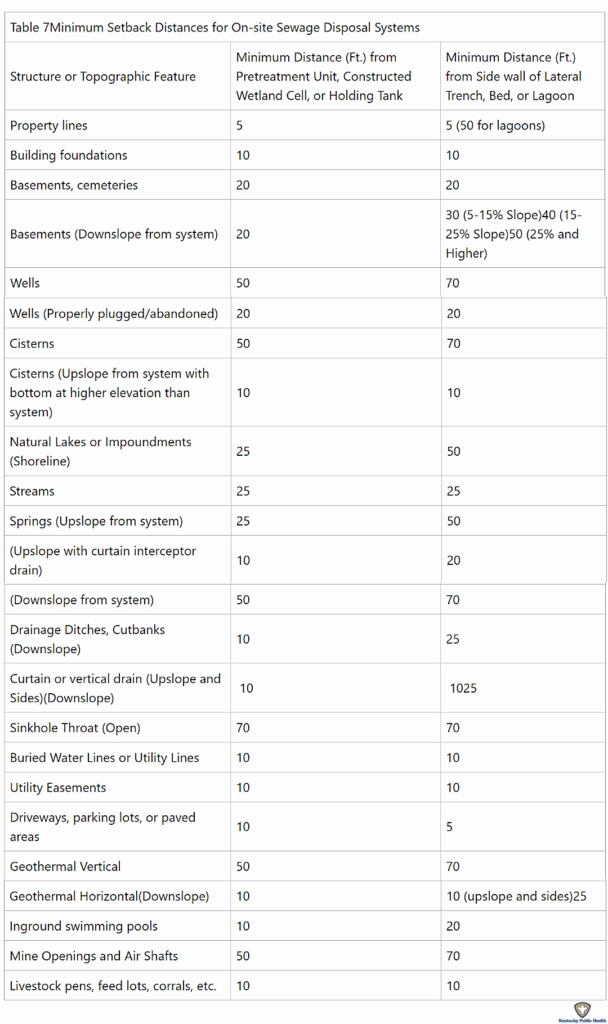
The design of the on-site septic tank system will vary and accommodate property features and layout. The number and type of components needed to complete the system will depend on the type of system to be installed and the size needed based on the size of the structure, expected wastewater flow, and the type of sewage system.
See the following design plan and proposed system draft example as an example of what can be expected and what may be suitable when applying for a permit.
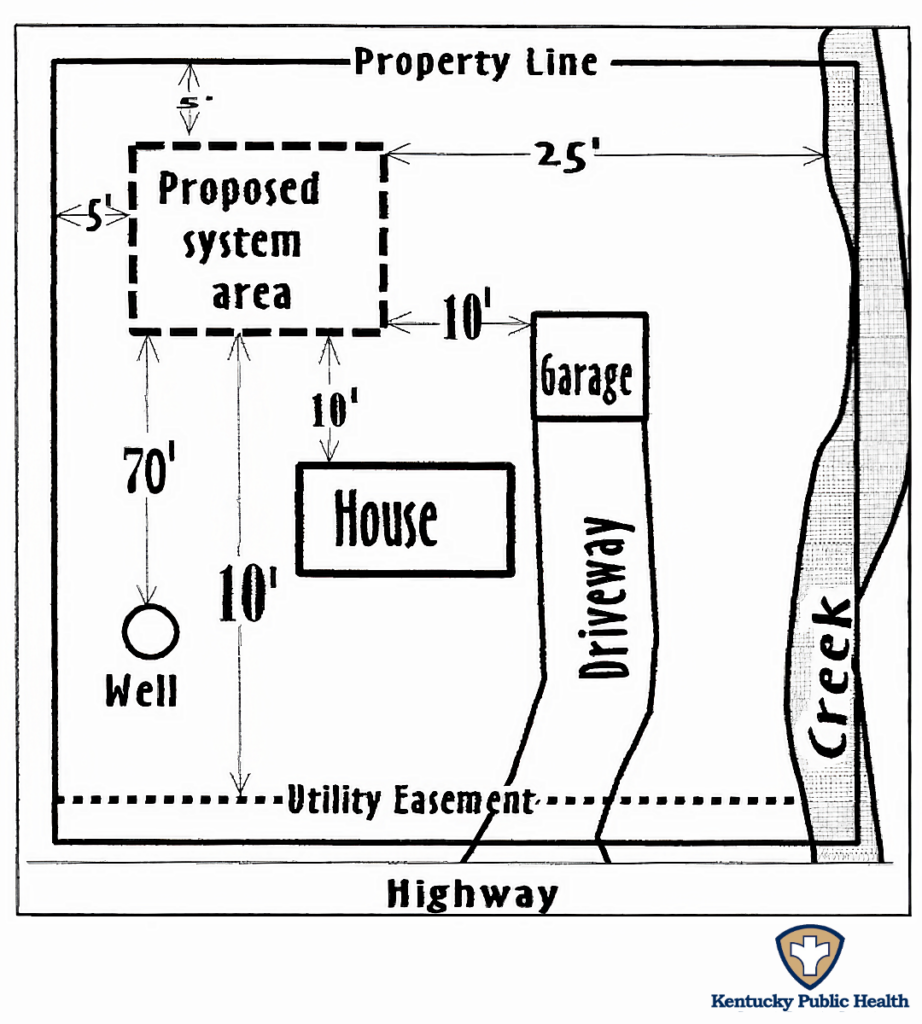
Septic Tank Sizes in Kentucky
Kentucky state regulations specify the minimum septic tank sizes required for a conventional, gravity fed sewage disposal system. Accordingly, septic tank sizes in Kentucky start at 1000 gallons for 3 bedroom homes and less, a 1250 gallon septic tank for 4 bedroom homes, and a 1500 gallon septic tank for 5 bedroom homes. Add 250 gallons onto the septic tank size for each additional bedroom over five. Also, add 250 gallons of septic tank size if a garbage disposal will be installed and used in the property.
See the following table from 902 KAR 10:085 for minimum septic tank sizes in Kentucky:
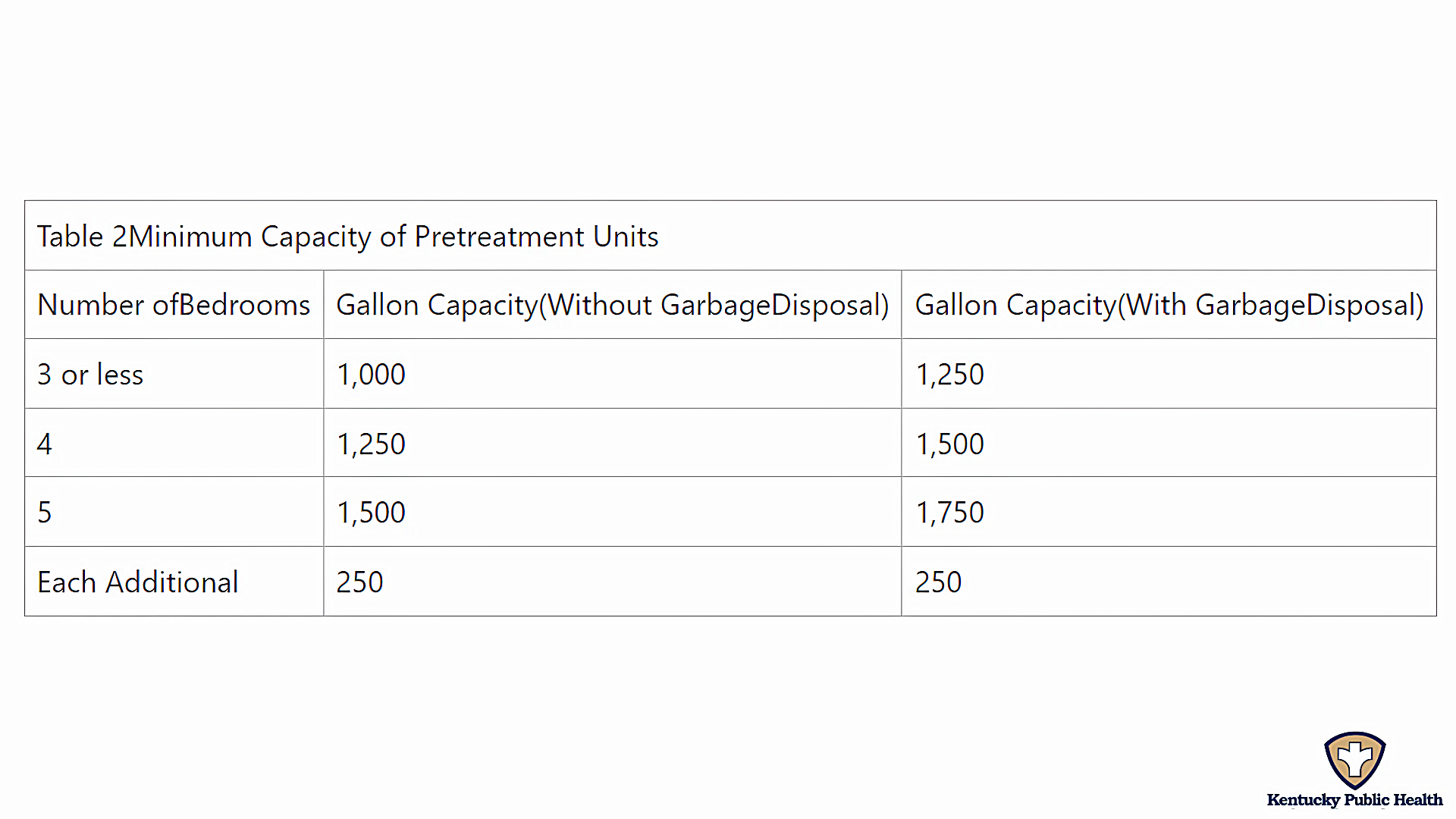
The National Tank Outlet offers polyethylene septic tanks in the Kentucky minimum required sizes and more, and manhole risers to bring tank access up to the surface for when maintenance and inspections are needed.
Inspections
After installation of the on-site sewage disposal system is finished and prior to complete backfill, a certified inspector from the local health department must be scheduled to conduct an inspection of the system. Once inspection is complete and the system meets the requirements of the site evaluation, the permit, and is verified to comply with state regulatory codes, a final approval will be granted. Following final approval, the new on-site septic system can be properly backfilled and then safely and confidently used.
Maintenance and Pumping
Septic tank maintenance is a key part of ensuring trouble free service from a septic system for many years to come. Maintenance of a conventional on-site sewage system will include having the tank pumped to remove built-up solids, in the form of scum and sludge, and cleaning the effluent filter. Failure to have the septic tank pumped out regularly can lead to significant problems such as solids reaching and clogging the lateral field or backing up into the property. How often solids need to be pumped from the tank will depend on the size of the septic tank, the volume of wastewater entering the tank, and the volume of solids in the wastewater, such as from a garbage disposal.
Need a Septic Tank in Kentucky? Choose the National Tank Outlet to Supply
Ensuring a septic tank system is correctly prepared, placed, installed, and maintained is vital to its safe and efficient operation and is an important aspect of property ownership in Kentucky. All properties require wastewater management whether it’s a city-provided sewer or an on-site sewage disposal system. When a septic tank is required, the National Tank Outlet provides high quality, durable HDPE plastic septic tanks rotational mold manufactured in the USA by America’s top manufacturers approved by the KY DPH to exceed state regulations for peace of mind and long term reliability.
Our expert team is always ready to assist in choosing the right septic tank for your specific needs. Visit our website today to view our range of Kentucky approved septic tank options. With a full selection of common septic tank sizes in stock, you can save with our competitive pricing. Choose National Tank Outlet for your septic tank project in Kentucky—where quality meets compliance.
Additional Resources
- Kentucky Department for Public Health
- Homeowner’s Manual for Onsite Sewage Disposal Systems | Kentucky CHFS
- Onsite Sewage Disposal Systems Program | Kentucky Environmental Management Branch
- Kentucky Administrative Regulations Title 902 KAR Chapter 10 | Kentucky General Assembly
- Homeowner’s Septic System Guide and Record Keeping Folder | KY Energy and Environment Cabinet
- Farmstead Septic Systems and On-Site Sewage Disposal BMP | KY Energy and Environment Cabinet
- Homeowner Tips for Septic Systems | KY CHFS
- List of Local Health Departments | KY Department for Public Health
- Kentucky Local Health Department Contacts Listing | KY CHFS
- A Kentucky Homeowners Guide to Septic Systems | Green River District Health Department
- Application & Permitting Process for Individual Home Sewage Systems | KY CHFS
Disclaimer: This guide is intended to provide general information and expectations around the installation and requirements of a septic tank and system in the state of Kentucky and is not intended to substitute for advice, legal counsel, or consultation from state departments or licensed professionals. The information provided is current and accurate to the best of our knowledge at the time of this writing. For specific advice on your individual situation, please consult with the Kentucky Department of Public Health (DPH) and the Environmental Management Branch (EMB), your local health department, or a certified septic installer.
